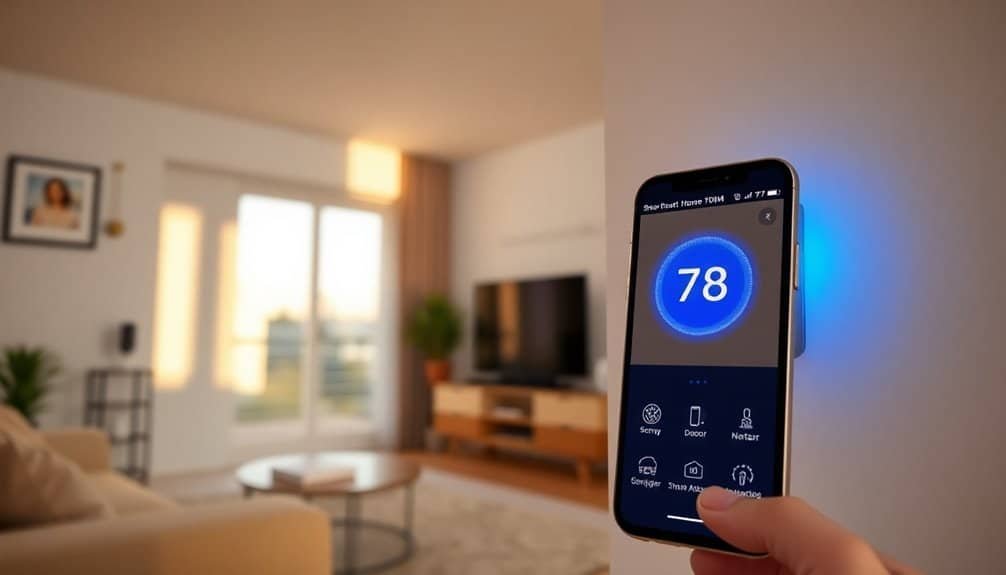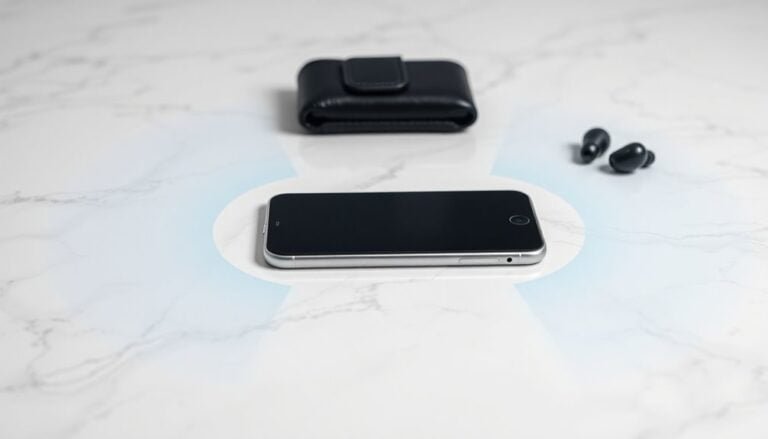How to Safely Use Smart Home Devices

To ensure the safe use of smart home devices, use strong, unique passwords and enable multi-factor authentication. Regularly update device firmware and limit third-party connections to reduce security vulnerabilities.
Consider isolating IoT devices on a separate network to minimize exposure risks. By implementing these practices, you enhance your security posture, with further strategies available to bolster smart home defenses.
Disclaimer: As an affiliate, I may collect a share of sales from the links on this page.
Understanding the Risks of Smart Home Devices

As smart home devices gain popularity, it’s crucial to understand their inherent risks. Around 80% of Internet of Things (IoT) devices have security vulnerabilities, with many containing weak default settings or hidden backdoors. These flaws allow malware and unauthorized access to exploit devices like locks and cameras. Breaching one device can enable lateral movement, compromising your entire network. Additionally, these devices often expose personal data, including geolocation and unique identifiers, paving the way for surveillance and data collection. Local networks are perceived as safe but can expose sensitive data through certain protocols, increasing the risk of privacy breaches. Finally, weak security may lead to unauthorized control, disrupting your home environment and risking privacy breaches.
Stay vigilant and informed.
Importance of Security Certifications
When considering smart home devices, it’s essential to understand the role of security certifications. Certifications like UL and CTIA IoT guarantee compliance with safety standards and minimum security requirements, enhancing data privacy.
PSA Certified employs a three-tiered approach to evaluate hardware, software, and lifecycle security. These certifications align devices with industry standards, increasing trust and reliability among consumers. Moreover, IoT security certifications validate knowledge and skills in securing devices, making them crucial for maintaining a safe environment.
Furthermore, they support manufacturers in meeting regulatory requirements, reducing legal risks. Certified devices not only offer better protection against cyber threats but also assure consumers that they adhere to rigorous testing and evaluation processes, promoting overall peace of mind.
Essential Security Practices for Smart Devices

To enhance the security of your smart home devices, implementing essential security practices is crucial.
Start by using strong, unique passwords on each device, avoiding default settings. Enable multi-factor authentication (MFA) to add an extra layer of security. Limit third-party devices to reduce vulnerabilities and make sure only authorized users can access your smart devices. IoT devices are common targets for cyber attacks, making it imperative to remain vigilant about securing your network.
Regularly update device firmware to include the latest security patches. Additionally, consider isolating your IoT devices on a separate network.
Monitoring Your Smart Home Network
Monitoring your smart home network is essential for maintaining security and performance. Utilize effective tools to optimize your network’s efficiency:
- PRTG: Start with this detailed software that offers a free version for basic needs.
- GlassWire: Track network activity effortlessly with its user-friendly interface.
- Managed Switches: Use devices like Cisco or Netgear to implement network mirroring, enhancing traffic analysis.
Establish a performance baseline to identify abnormalities. Configure your network switch properly, ensuring all devices connect securely.
Proactive monitoring prevents potential issues, optimizing your smart home experience and safeguarding your connected devices.
Responding to Security Breaches

Recognizing a security breach quickly is essential for safeguarding your smart home. Enable breach notifications to receive immediate alerts.
Regularly monitor device activity logs, identifying unauthorized access. Look for behavioral anomalies, such as devices turning on/off unexpectedly. Employ network monitoring tools to flag unusual traffic.
Assess the scope of the breach by identifying affected devices and evaluating data exposure. Disconnect compromised devices and change all relevant passwords promptly.
Revoke unauthorized access and disable remote features temporarily. Notify service providers about the breach and involve cybersecurity experts for thorough analysis.
Maintain vigilance by monitoring for future phishing attempts.
Industry Trends in Smart Home Technology
As smart home technology continues to evolve, consumers find themselves at the forefront of a rapidly changing landscape. Adoption is on the rise, with over half of U.S. consumers expected to embrace smart devices by 2025.
Key trends shaping this market include:
- Seamless control for lighting, temperature, and security.
- An increasing preference for voice-controlled devices.
- Advanced security systems becoming standard in smart homes.
The average U.S. household incorporates around 17 connected devices, enhancing everyday convenience.
However, ensuring interoperability across platforms remains a challenge that the industry must address to meet consumer expectations for integrated, efficient living environments.
Unique Risks Associated With Different Device Types
When it comes to smart home devices, each type carries unique risks that can compromise both security and privacy.
For security devices, default passwords and outdated firmware make them prime targets for hackers.
Smart appliances often lack security features, exposing sensitive data to breaches.
Entertainment devices connect to cloud services, risking unauthorized access and potential surveillance.
Automation devices might experience disruptions that affect essential systems like HVAC.
Exposure of personal data, including location and financial information, poses privacy concerns.
Understanding these risks helps you implement effective measures to safeguard your smart home ecosystem from potential threats.
Educating Yourself About Smart Device Security
How can you guarantee that your smart home remains secure in an increasingly connected world? Educating yourself about smart device security is essential.
Start by understanding the basics of password management, network encryption, and device hygiene. Implement strong, unique passwords, and regularly update firmware to protect against vulnerabilities.
- Use WPA3 encryption for your network.
- Check for updates regularly to enhance security.
- Educate yourself about common threats.
Knowledge of these principles helps you maintain a secure smart home environment, reducing risks associated with potential breaches and ensuring the safety of your personal data and devices.
Future of Smart Home Safety Standards
Advancements in smart home security hinge on the future of safety standards, which will greatly impact how users interact with their devices.
The adoption of the Matter protocol will enhance interoperability, allowing devices from different manufacturers to communicate seamlessly. Thread integration will provide low-latency communication, improving reliability.
Future privacy measures will utilize advanced encryption, multi-factor authentication, and customizable settings to secure user data.
AI will enhance security through predictive maintenance and real-time threat detection.
Regulatory developments will enforce compliance with cybersecurity standards, ensuring a consistent approach across the industry, fostering a more secure and user-friendly smart home environment.
Frequently Asked Questions
How Can I Choose the Right Smart Home Device for My Needs?
To choose the right smart home device, evaluate your needs and budget, compare features across brands, guarantee compatibility with your existing setup, and read user reviews for insights on reliability and performance.
Are There Specific Smart Devices I Should Avoid Altogether?
Like trusting a wolf in sheep’s clothing, you should avoid smart TVs and IP cameras. Their vulnerabilities could compromise your privacy. Choose wisely; not every device is a friend to your home’s safety.
How Do Smart Devices Impact My Home’s Energy Efficiency?
Smart devices greatly boost your home’s energy efficiency. They optimize usage, reduce consumption, and lower utility bills. By integrating multiple devices, you can enhance their impact, creating a more sustainable and cost-effective living environment.
What Should I Do if a Device Becomes Obsolete?
When a device becomes obsolete, you should consider replacing it, explore alternative support options, or connect with communities for help. Assess costs and functionality carefully to make the best choice for your needs.
Can I Integrate Different Brands of Smart Devices Safely?
You can integrate different brands of smart devices safely. Just guarantee they support common standards like Matter, use strong encryption, set unique passwords, and regularly update your devices to enhance compatibility and security.
Conclusion
Navigating smart home devices requires understanding potential risks. Implement security certifications, use strong passwords, and regularly monitor your network to protect against breaches. Each device has unique vulnerabilities, so continuous learning is crucial. As technology evolves, update your safety strategies to ensure your home remains secure.






